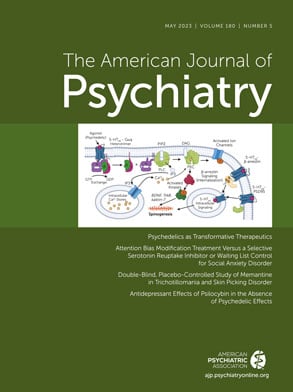Attention Bias Modification Treatment Versus a Selective Serotonin Reuptake Inhibitor Or Waiting List Control for Social Anxiety Disorder: A Randomized Clinical Trial
Abstract
Objective:
Methods:
Results:
Conclusions:
Methods
Participants
Sample Size Calculation
Randomization and Blinding
Interventions
GC-MRT.
SSRI.
Waiting list control.
Study Outcomes
Trial Procedures
Statistical Analysis
Results

| Variable and Assessment | GC-MRT Group (N=35) | SSRI Group (N=35) | Control Group (N=35) | |||
|---|---|---|---|---|---|---|
| Mean | SD | Mean | SD | Mean | SD | |
| Age (years) | 30.80 | 8.06 | 30.83 | 9.71 | 30.51 | 6.98 |
| LSAS score | ||||||
| Baseline | 76.83 | 15.51 | 80.03 | 14.28 | 81.49 | 16.50 |
| Midtreatment | 59.00 | 18.96 | 60.86 | 19.24 | 75.97 | 17.52 |
| Posttreatment | 56.78 | 19.71 | 54.70 | 20.04 | 74.03 | 18.16 |
| SPIN score | ||||||
| Baseline | 47.80 | 9.74 | 48.06 | 7.37 | 49.60 | 7.94 |
| Midtreatment | 34.46 | 12.07 | 32.87 | 12.92 | 44.61 | 10.06 |
| Posttreatment | 35.12 | 13.89 | 30.85 | 12.92 | 44.14 | 10.18 |
| PHQ-9 score | ||||||
| Baseline | 13.26 | 5.01 | 13.94 | 5.85 | 14.74 | 5.35 |
| Posttreatment | 9.73 | 5.53 | 7.83 | 4.97 | 11.52 | 7.30 |
| % Dwell time on threat | ||||||
| Baseline | 45.29 | 10.48 | 47.34 | 8.19 | 46.93 | 6.92 |
| Midtreatment | 37.40 | 14.31 | 45.00 | 9.90 | 46.14 | 8.44 |
| Posttreatment | 35.45 | 15.01 | 44.37 | 8.77 | 46.21 | 8.02 |
| N | % | N | % | N | % | |
| Maleb | 22 | 62.86 | 19 | 54.29 | 21 | 60.00 |
| Comorbidities | ||||||
| Mild depressive episode | 10 | 28.57 | 14 | 40.00 | 16 | 45.71 |
| Dysthymia | 4 | 11.43 | 4 | 11.43 | 3 | 8.57 |
| Generalized anxiety disorder | 3 | 8.57 | 6 | 17.14 | 4 | 11.43 |
| Panic disorder | 2 | 5.71 | 2 | 5.71 | 2 | 5.71 |
| Agoraphobia | 2 | 5.71 | 1 | 2.86 | 1 | 2.86 |
Symptom Severity
Primary outcome.

Secondary outcome.
Additional Clinical Outcomes
Cognitive Target Engagement

Adherence, Credibility, Expectation, and Treatment Satisfaction
Discussion
Footnote
Supplementary Material
- View/Download
- 304.72 KB
REFERENCES
Information & Authors
Information
Published In
History
Keywords
Authors
Competing Interests
Funding Information
Metrics & Citations
Metrics
Citations
Export Citations
If you have the appropriate software installed, you can download article citation data to the citation manager of your choice. Simply select your manager software from the list below and click Download.
For more information or tips please see 'Downloading to a citation manager' in the Help menu.
View Options
View options
PDF/EPUB
View PDF/EPUBLogin options
Already a subscriber? Access your subscription through your login credentials or your institution for full access to this article.
Personal login Institutional Login Open Athens loginNot a subscriber?
PsychiatryOnline subscription options offer access to the DSM-5-TR® library, books, journals, CME, and patient resources. This all-in-one virtual library provides psychiatrists and mental health professionals with key resources for diagnosis, treatment, research, and professional development.
Need more help? PsychiatryOnline Customer Service may be reached by emailing [email protected] or by calling 800-368-5777 (in the U.S.) or 703-907-7322 (outside the U.S.).

